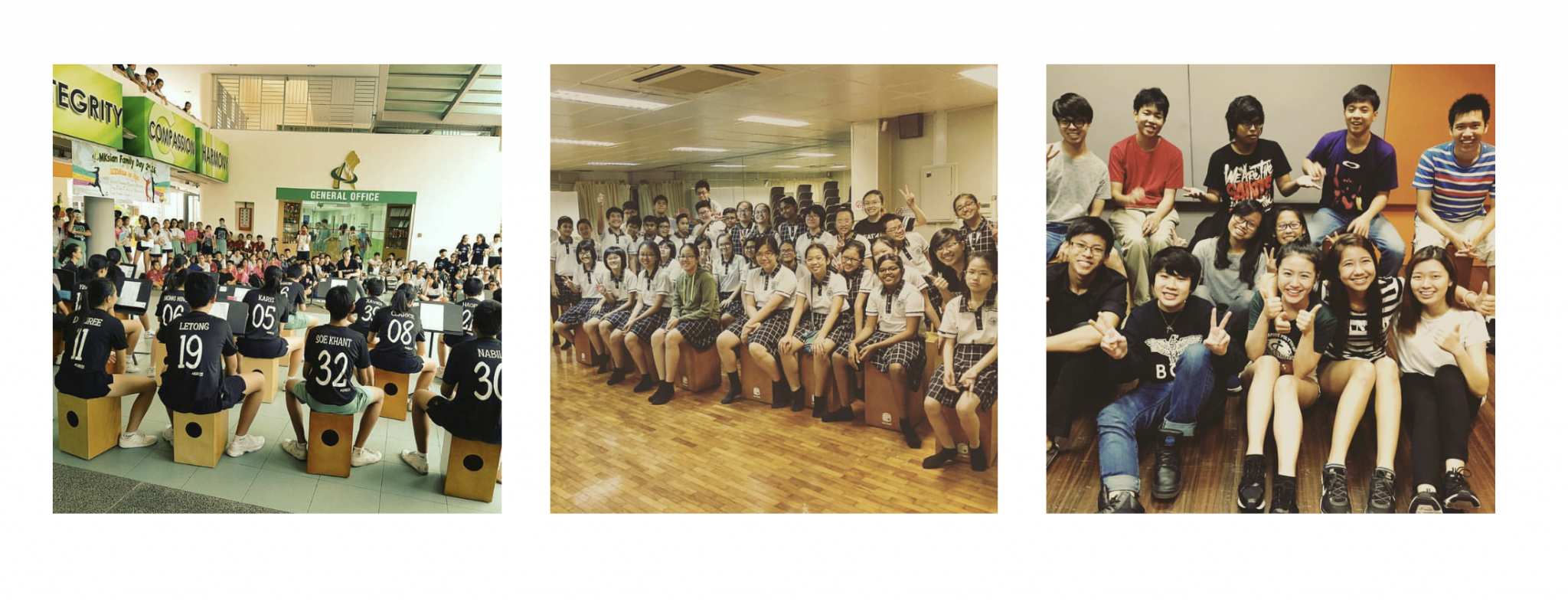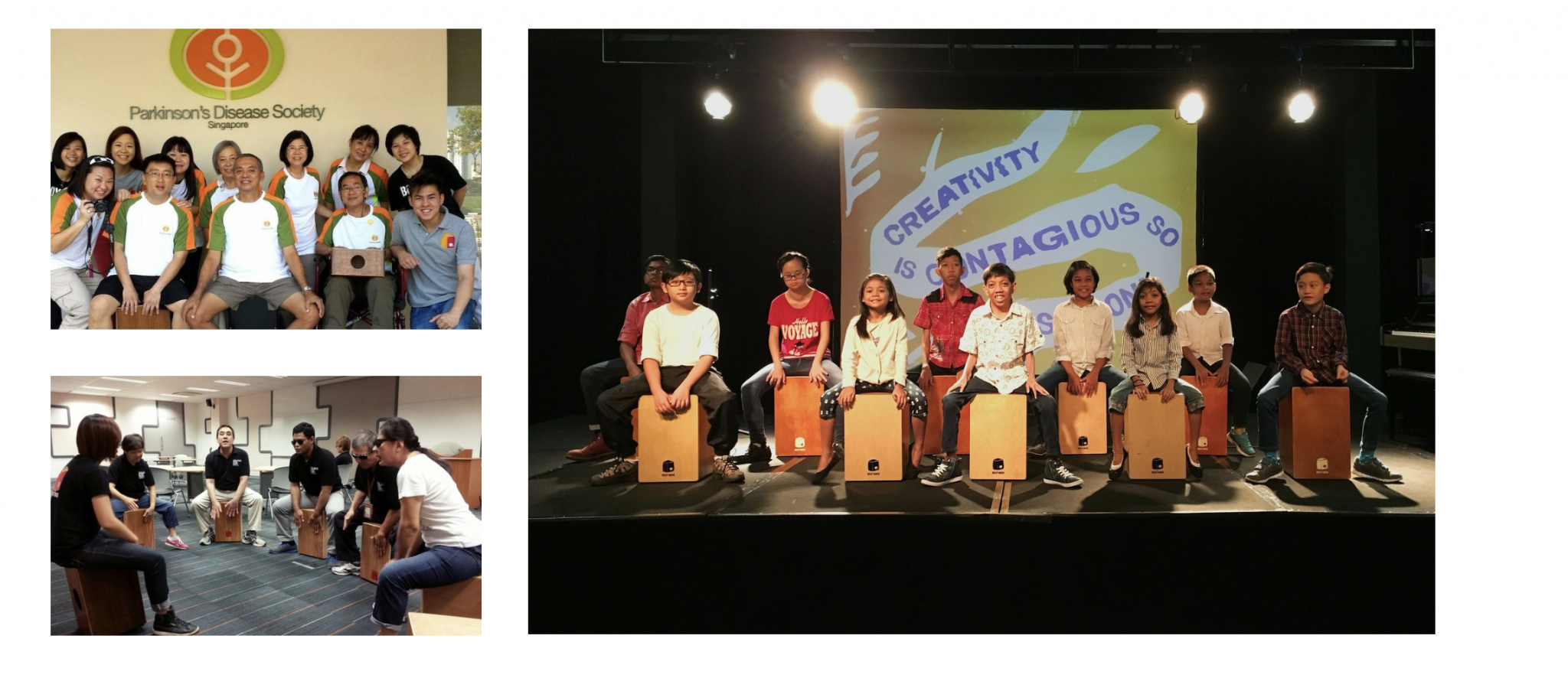Meet Arthur Choo, 31, artiste and founder of BEAT’ABOX Group, a cajon school in Singapore. Besides performing and conducting workshops for companies and schools, Arthur and his team hope to make the cajon (pronounced “kah-hone”, a wooden box played like a drum) the bridge between society and marginalised groups, including at-risk youth, senior citizens and people with disabilities. There are no barriers to taking up this art form at BEAT’ABOX—there are cajons specially designed for the hearing-impaired (they light up when struck), smaller-sized cajons that can fit into the laps of the wheelchair-bound, and so on. ISHAN SINGH speaks to Arthur about how he turned his passion for percussion into a social mission.
In a nutshell, what does BEAT’ABOX do? To me, BEAT’ABOX is where we educate and impart performance skills, as well as host shows to bring people together. When I started this cajon school in 2011, I wanted to be the first to bring the box drum to Singapore. We’ve since grown from a small community to an organisation.  How did you go from being a performer to a businessowner?
How did you go from being a performer to a businessowner?
Initially I was only playing for friends, family and a small community. However, I got into the performing industry after a programme manager took notice of a segment I did as part of a cheerleading event at Marine Parade. He was impressed by the “noise” and “hoo-ha” I was generating for a basketball match, and invited me back regularly. Playing the cajon gradually turned into a full-time performing career which spanned nearly 15 years. But in 2011, deciding I wanted to take the cajon to a larger stage, I established BEAT’ABOX. The school has since grown from having only three students to over 30,000 today. I’m so grateful to my team, all my teachers, and everyone who helped make this dream of mine possible.  So, the cajon’s not exactly a conventional instrument. What are some preconceived notions surrounding it?
So, the cajon’s not exactly a conventional instrument. What are some preconceived notions surrounding it?
A decade ago, maybe one in a thousand people knew what a cajon is. These days, the ratio has narrowed, but the misconceptions still abound. Some people think “you’re just replacing the drums”, but the cajon is really an entirely different art form in itself. Let me give an example—let’s say you’re well versed in street dance, but that doesn’t mean you can do jazz dance too. It takes patience when educating people in Singapore and around Asia about the cajon and convincing them it’s not synonymous with drums.

Yours was one of the first cajon schools in Singapore. Has the competition heated up lately?
In the beginning, we were a new and risky venture, and nobody really believed in what we were doing or took us that seriously. However, two of three years on, they saw how our cajon classes were taking off and many others started to copy us. That’s only normal. The key to staying viable is constant innovation—as both musician and businessowner, I get to flex both my competitive as well as creative muscles.  This leads to my next question: do you see yourself as an artiste who does business or a businessman involved in the arts?
This leads to my next question: do you see yourself as an artiste who does business or a businessman involved in the arts?
Now that we’ve been talking for awhile, I’m interested to hear what you think.
Personally, I would call you an artiste involved in business.
If being an artiste means you have a craft in performing arts and are actively practising this craft, then yes, I do consider myself an artiste. But that doesn’t limit me as a businessperson. Over the years, through business failures and mentorship, I’ve learned how to balance the creative and entrepreneurial aspects of my personality.  From your website, I see that you’ve held workshops for the Parkinson’s Disease Society, Club Rainbow, Singapore Boys’ Home and Lighthouse School, to name just a few. Can you share any memorable experiences?
From your website, I see that you’ve held workshops for the Parkinson’s Disease Society, Club Rainbow, Singapore Boys’ Home and Lighthouse School, to name just a few. Can you share any memorable experiences?
Yes. I was teaching a class comprising visually handicapped and hearing-impaired individuals, respectively. The former couldn’t see the positioning of their hands when playing particular tones, but that did not hinder them from participating whole-heartedly. This elicited a positive response from the hearing-impaired folks, who took their cue and joined in enthusiastically. Without their realising, these two groups had empowered each other. The end result was a lively performance, and this experience left a lasting impression on me.  Have you had any famous students?
Have you had any famous students?
I wouldn’t call them students, but I once got to meet Prime Minister Lee Hsien Loong and showed him how to play the cajon. Mr Tony Tan as well.
Let’s wrap things up with a fun fact. When you’re not playing or teaching the cajon, what kind of music are you listening to?
I’m a pop music fan, so I love Michael Jackson. My guilty pleasures are songs by the Backstreet Boys and Westlife. I also enjoy Mandopop—my favourite singers are Jay Chou and JJ Lin.
Top photo by Azmi Danuri. All other photos courtesy of Arthur Choo and BEAT’ABOX Group.
 |
Ishan Singh is a second-year undergraduate at the Singapore Management University’s Lee Kong Chian School of Business, and an Editorial Assistant of Social Space Magazine. He spends any spare time he has rapping or producing music, and hopes to pursue a career in music. Passionate about the arts and writing, Ishan hopes to write articles and make videos that shed light on the importance of the arts in our communities. He can be reached at ishan.singh.2018@business.smu.edu.sg |








Comments